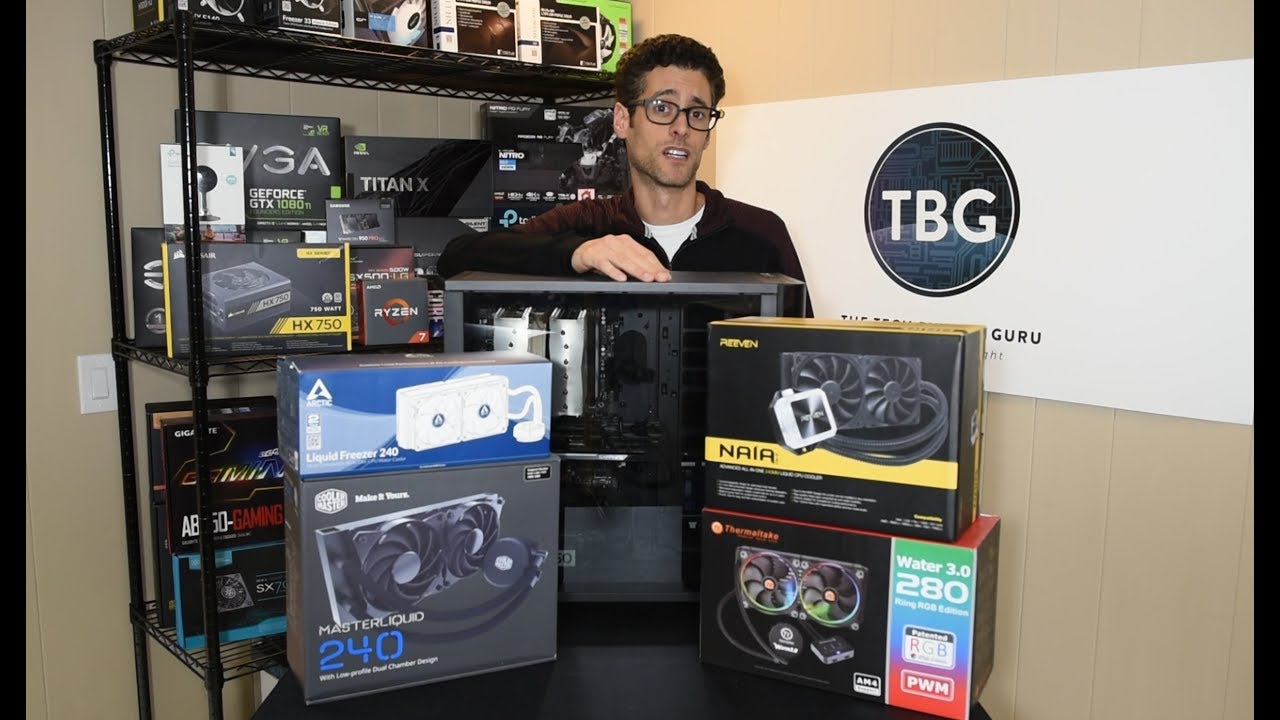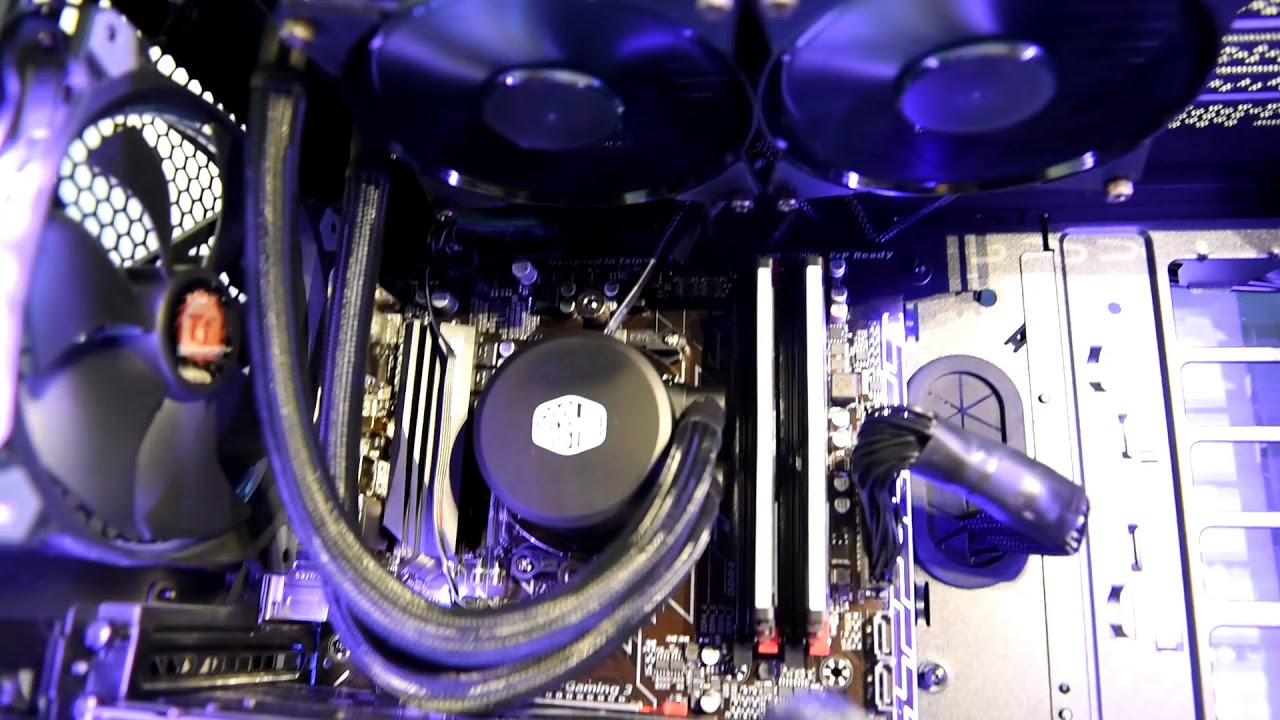The CPU Liquid Cooler Shootout: Pushing the Limits
Introduction
If you take a look through the CPU Cooler Reviews section of The Tech Buyer’s Guru, you’ll see we’ve tested quite a few models over the years. In fact, in all, we’ve had our hands on over two dozen coolers, of all shapes, sizes, and price classes. But one area we haven’t spent quite as much time on is liquid coolers. It’s not that we haven’t tested them – in fact, the original Corsair Hydro H100i showed up in our comprehensive Complete Guide to CPU Coolers published in May 2015, which served as an introduction to the full range of CPU coolers on the market, and we returned to the subject with a review of the Corsair Hydro H100i v2 in early 2016. At that time, Corsair had a near lock on the “All-in-One” (AIO) market, and the H100i v2 has been the best selling liquid cooler ever since.
But nothing stands still in technology, and just as you typically shouldn’t buy a CPU, video card, or SSD released two or three years ago, older CPU coolers should be viewed with a critical eye. Sometimes old doesn’t mean “best,” even if it is a best-seller. It may just mean that the word hasn’t got out that old means old! In the past few years, a huge number of liquid coolers have hit the market, along with several new AMD and Intel CPU sockets. So we decided it was the right time for a full liquid cooler shootout. The one requirement: the cooler had to be a new model, and it had to include an AMD AM4 bracket right in the box so that Ryzen CPUs were supported. That excluded Corsair entirely, which actually hasn’t shipped a new cooler in two years, and may be exiting the market, based on our analysis of its product showcases at CES and PAX over the past few years (where coolers often haven’t even appeared). We’ll actually circle back to the H100i v2 we have on hand to discuss it at the end of this article, but suffice it to say that it has been thoroughly out-classed by newer designs, and will soon be “existing stage right” from all of our buyer’s guides.
Luckily, over the past few years, we’ve developed enough of a reputation and rapport with all the biggest CPU cooler manufacturers that when we come calling, they always answer. This time around we’ve got Arctic, CoolerMaster, Reeven, and Thermaltake lined up for the event. Here’s a photo of the four coolers we’re testing, followed by their retail prices as of our publication date:
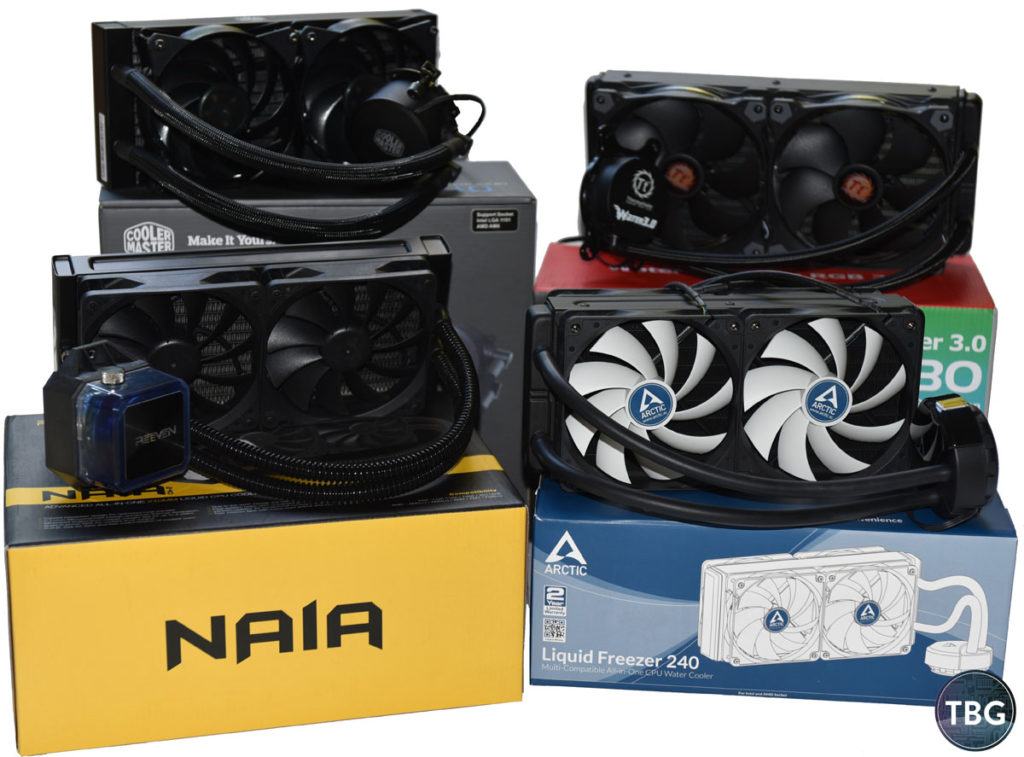
Clockwise from top-left:
- CoolerMaster Master Liquid 240 – $88 (special thanks to CoolerMaster for providing this review sample)
- Thermaltake Water 3.0 280 Riing RGB – $150 (special thanks to Thermaltake for providing this review sample)
- Arctic Liquid Freezer 240 – $90 (special thanks to Arctic for providing this review sample)
- Reeven Naia 240 – $112 (special thanks to Reeven for providing this review sample)
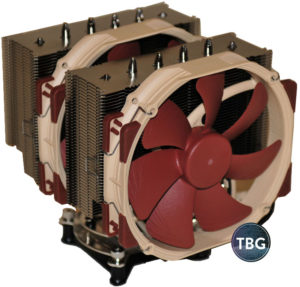 As a baseline reference model, we’re also testing Noctua’s NH-D15 SE-AM4, the best air cooler on the market. It’s a special AM4-only model, but the NH-D15 can also be found with standard Intel mounts. It comes in at $90, and serves as an interesting counterpoint to the liquid coolers that sell for around the same price. While we’ve never experienced any issues with reliability of liquid coolers, we know a lot of purists would prefer not to mix water with their precious high-end PCs, and for them, the NH-D15 can holds its own, as our tests will show.
As a baseline reference model, we’re also testing Noctua’s NH-D15 SE-AM4, the best air cooler on the market. It’s a special AM4-only model, but the NH-D15 can also be found with standard Intel mounts. It comes in at $90, and serves as an interesting counterpoint to the liquid coolers that sell for around the same price. While we’ve never experienced any issues with reliability of liquid coolers, we know a lot of purists would prefer not to mix water with their precious high-end PCs, and for them, the NH-D15 can holds its own, as our tests will show.
Note that manufacturers were so excited about this AM4-focused review that we also received six additional air coolers, from Arctic, Cryorig, Noctua, Scythe (which sent two!), and SilverStone, and we’ll be testing them in a separate article.
Test Method
As always, we benchmark coolers on the latest test platforms, meaning you know how these coolers will work on gear you’re buying today.
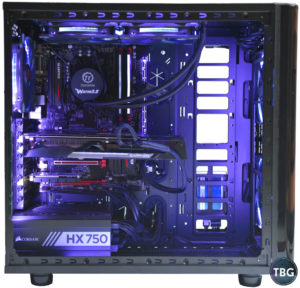 Here’s the system we used to rate our contenders:
Here’s the system we used to rate our contenders:
- CPU: AMD Ryzen 7 1700 (thank you to AMD for providing this review sample)
- Motherboard: Gigabyte GA-AB350-Gaming 3
- Video Card: Sapphire Radeon R9 Fury Nitro+ 4GB
- SSD #1: Samsung 960 Evo 500GB M.2
- SSD #2: Crucial MX300 525GB 2.5″
- RAM: GeIL 2x8GB Super Luce DDR4-3000
- Case: Thermaltake View 31 RGB (thank you to Thermaltake for providing this review sample)
- Power Supply: Corsair HX750 Platinum (thank you to Corsair and Newegg for providing this review sample)
- Operating System: Windows 10 Flash Drive
With AMD’s Ryzen platform taking the market by storm (we estimate that it now represents 20% of all CPU sales, up from close to zero at the beginning of 2017), we felt it was critical to show the platform some love by using it in this roundup. When Ryzen CPUs hit the market, one of the biggest problems was actually finding a cooler that would work with them. While most coolers still don’t have the necessary AM4 brackets in the box, cooler manufacturers realize that all their new models must have them if they’re going to become serious contenders for the next best seller.
A couple of other components deserve a bit of explanation. This being our AMD platform, we felt we had to include an AMD-based video card, but AMD’s new Vega series is a complete flop in our opinion, so we turned to our trusty Sapphire Radeon Fury Nitro. No, you shouldn’t buy it today (and in fact, you can’t because it’s been discontinued), but it’s still a potent gaming weapon, easily beating out anything you can find for under $300 today (we picked ours up for $250 a year ago, which is a sign of how the mid-priced market has stalled!). And the other great thing about it is that it has a zero-fan mode, which was critical to our noise testing. During all of our CPU cooler testing, it remained completely and utterly silent.
Finally, we have our case of choice, the Thermaltake View 31 RGB. In addition to being quite a looker, this is the perfect platform for cooler testing. If there’s one thing Thermaltake understands, it’s how to design a case that can actually fit any cooler on the market. And this shouldn’t be a surprise, given that Thermaltake markets more coolers than any other manufacturer in the world, including some very fancy custom loop solutions. We’ve grown pretty tired of other case manufacturers (including otherwise-excellent ones like SilverStone and Phanteks) marketing their mid-sized cases as having broad 240mm and 280mm cooler compatibility when they really don’t. We love these cases, but not for liquid cooling. Thermaltake gets it right, and sure enough, we didn’t encounter a single issue during any of our cooler testing with the View 31 – it was a perfect platform for this test.
To provide a true challenge to these high-powered coolers, we skipped stock testing all together, as our Ryzen 7 1700 runs at a leisurely 3.2GHz, with a rated TDP of just 65W. That’s not nearly stressful enough to even bother with liquid cooling. We instead turned up the heat with an overclock of 3.8GHz, using 1.27V. We tried to dial in a 3.9GHz overclock with less than 1.35V (the reasonable limit to ensure CPU longevity), but couldn’t get it stable. Note that a lot of reviewers boasted of Ryzen overclocks of 4GHz and even 4.1GHz, but they typically were using 1.45V to get there. You can kiss those CPUs goodbye in the long run.
In terms of cooler settings, most reviews simply run coolers at maximum RPM, show the results, and on a separate page might provide noise data. Frankly, this just isn’t good enough. Performance data divorced from noise data is meaningless, and it has encouraged manufacturers to “juice” the benchmarks by shipping coolers with ever-faster fans and incredibly-noisy pumps. Therefore we ran our coolers using PWM and/or DC motherboard controls for both fans and pumps. This allowed them to ramp down at idle, and ramp up for a moderate and extreme loads. We used the motherboard’s standard fan profile, except for one tweak: we leveled out the profile through 40°C to eliminate the constant changes in fan and pump speeds that otherwise occur (and annoy) during idle periods as the CPU fluctuates between 30°C and 40°C.
And what about the actual tests we performed? We used three different test scenarios to benchmark our coolers. First is idle at the desktop, where we report the minimum over a five-minute span (minor OS operations can spike temperatures momentarily, but these spikes can be ignored). Second is load in the CPU-z built-in benchmark, where we report the maximum after a 5-minute run. The third is Prime95 Small FFTs, where we report the maximum after a 10-minute run. As you’ll see, each of the tests we ran illustrates a distinct facet of cooler performance, allowing us (and you) to gain a better understanding not just of how these coolers perform, but why they perform the way they do. Temperature data are collected using the wonderful app HWMonitor. All analysis was conducted with an ambient temperature of 69.5°F. Noise data was collected with a sound meter placed at the top of the case, a few inches from the radiator mount, and all other fans in the system were shut off, including the case fans and power supply fans.
All right, with that introduction out of the way, it’s time to get into the nitty-gritty of our results, starting with a review of installation!
Installation
Before we get into the installation of each cooler, we thought we’d give you a chance to view our Unboxing Video, which provides more detail on our testing platform of choice, and also highlights some of the unique features of each of our liquid CPU cooler contenders.
To further assist readers who’d like to use any of the other coolers we tested, we’re providing a few installation notes for each model below.
Noctua NH-D15
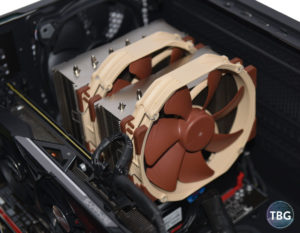 Noctua originated the concept of a truly premium cooler, and the NH-D15 is its very best model. AMD was wise to partner with Noctua to arrange that highly-capable, AM4-compatible coolers were available at Ryzen’s launch in March 2017. Alas, the AM4 edition of the NH-D15 had two problems out of the gate: it sold out immediately (taking weeks to restock), and to make sure that AMD owners were getting an up-to-date package, this AM4-only SKU was released. That means despite costing the same as the original NH-D15, it does not include brackets for any Intel CPUs, nor older AMD CPUs.
Noctua originated the concept of a truly premium cooler, and the NH-D15 is its very best model. AMD was wise to partner with Noctua to arrange that highly-capable, AM4-compatible coolers were available at Ryzen’s launch in March 2017. Alas, the AM4 edition of the NH-D15 had two problems out of the gate: it sold out immediately (taking weeks to restock), and to make sure that AMD owners were getting an up-to-date package, this AM4-only SKU was released. That means despite costing the same as the original NH-D15, it does not include brackets for any Intel CPUs, nor older AMD CPUs.
Luckily, the AM4 bracket was designed to perfection by Noctua, and this cooler took us only 20 minutes to install, making it the quickest (if not quite the easiest) installation in our roundup. Getting the bracket installed was simple, dropping the D15 into position was not. The D15 is extremely large, and it must be installed without its fans attached to provide access to the mounting bolts. Getting those fans and their associated clips on can be a huge hassle when it’s inside a system. It wasn’t too bad in our Thermaltake case, which has massive headroom above the cooler, but in other cases, getting those fans on will probably lead to some cut knuckles and maybe a few curse words too. Connecting the fan power leads to the motherboard fan headers can be similarly challenging – we recommend you attach them before clipping on the fans. One last problem was that the front fan sits right above the RAM slots, and we had to raise it 8mm to allow it to clear our high-profile LED RAM heatsinks. That made the cooler a total of 173mm tall, which is going to push the limit of many cases in terms of width. To its credit, Noctua includes a tube of its excellent NT-H1 thermal paste, which is very easy to apply, and should be enough for at least two, if not three applications.
Overall, if you like the “mouthful of metal” look, Noctua NH-D15 SE-AM4 cooler provides it, but this model isn’t nearly as elegant as the rest of the coolers in Noctua’s air cooler lineup.
Arctic Liquid Freezer 240
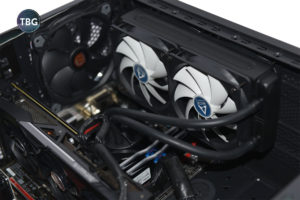 Oh, goodness, where do we start? This cooler was an absolute beast to install, taking a total of 40 minutes, the longest in our test. The crux of the problem is the dual sets of fans. To mount the radiator, which itself is bigger (at 38mm thick) and heavier than any other radiator in the test, you have to hold the radiator in place, while simultaneously holding two fans above it, and then screwing in eight screws from above through the fans and then the radiator. Of course, this is after you’ve already attached the lower layer of fans, making the whole contraption just incredibly ungainly.
Oh, goodness, where do we start? This cooler was an absolute beast to install, taking a total of 40 minutes, the longest in our test. The crux of the problem is the dual sets of fans. To mount the radiator, which itself is bigger (at 38mm thick) and heavier than any other radiator in the test, you have to hold the radiator in place, while simultaneously holding two fans above it, and then screwing in eight screws from above through the fans and then the radiator. Of course, this is after you’ve already attached the lower layer of fans, making the whole contraption just incredibly ungainly.
Making matters worse were the absurdly-long fan leads – each of the four fans had a power lead that was about 18 inches long, which created a massive amount of cable spaghetti for us to hide behind the motherboard. We simply can’t imagine what Arctic was thinking with these – were they surplus from some other product line? Maybe the idea was that in most case, this giant cooler would have to be mounted in front, but even then, you’d need 12 inches at most, and this could be taken care of with a simple extension cord, rather than making every fan into its own extension cord.
While Arctic includes its well-regarded MX-4 thermal paste, it comes in a squeeze packet, which is far messier and harder to use than a syringe tube like most of the other contenders in our group. It just feels downmarket, and while this cooler is a bargain at $90, it isn’t cheap. There were a few other peculiar design choices too. The Liquid Freezer is the only cooler in our roundup that does not have positionable hoses; they are fixed into the cooling block. And shockingly, the Arctic logo has been silkscreened upside-down on this block. Yes, we installed it as recommended in the manual, and yes, it is shown with an upside-down logo. You could certainly install it right-side up (with the hoses at the top of the block), but doing so may cause performance to suffer, as the liquid would be trapped in the bottom of the block.
So yeah, we weren’t impressed with Arctic’s installation or aesthetics. Performance, on the other hand, was another story, as you’ll soon find out.
CoolerMaster MasterLiquid 240
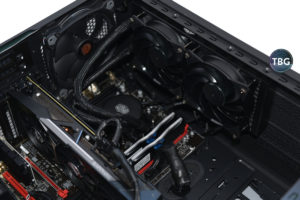 CoolerMaster does everything right with this bargain-priced cooler. It took just 25 minutes for us to install, and it was by far the easiest, beating out even Noctua’s air cooler. First, it’s the only cooler to use AMD’s standard AM4 retention bracket, meaning you don’t have to take the time to remove it and replace it with a proprietary one. The cooling block is simply lowered between the two sides of the AMD bracket, and is hand-tightened using a standard AMD clip mechanism. Attaching the fans to the radiator was similar to other models, but we really liked the rubber anti-vibration pads they had, a feature only the much more expensive Thermaltake offers.
CoolerMaster does everything right with this bargain-priced cooler. It took just 25 minutes for us to install, and it was by far the easiest, beating out even Noctua’s air cooler. First, it’s the only cooler to use AMD’s standard AM4 retention bracket, meaning you don’t have to take the time to remove it and replace it with a proprietary one. The cooling block is simply lowered between the two sides of the AMD bracket, and is hand-tightened using a standard AMD clip mechanism. Attaching the fans to the radiator was similar to other models, but we really liked the rubber anti-vibration pads they had, a feature only the much more expensive Thermaltake offers.
Just two minor installation notes. First, the thermal paste CoolerMaster provides is really runny, making it extremely hard to use if the system is standing up vertically. You really need to lay the system on its side to prevent it from running right off your CPU. It’s probably not the best stuff in the world, but as with all the models in the test, we used the supplied paste. Secondly, the hoses on this cooler were a bit shorter than the other coolers in our test (at 37cm long), wo we installed it with the hoses at the rear of the case to avoid stretching them unnecessarily.
Reeven Naia 240
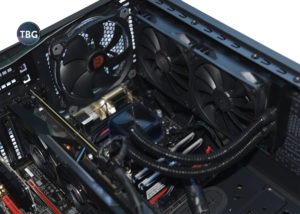 The Naia 240 took us 30 minutes to install, and while not difficult, it was a bit trickier than the CoolerMaster. That’s because it does require the removal of the stock AMD retention bracket and backplate. Plus, the Reeven bracket uses odd bolts that must be slid into tiny little notches – it would be easy to miss this if you’re not paying close attention, which would lead to an improper installation. The bracket is secured with thumbscrews that are truly thumb-only, without indentations for a screwdriver. We always think it’s best to give users the option to use a screwdriver in case they don’t have good dexterity or can’t easily reach their fingers into the system. Furthermore, it guarantees a tighter fit.
The Naia 240 took us 30 minutes to install, and while not difficult, it was a bit trickier than the CoolerMaster. That’s because it does require the removal of the stock AMD retention bracket and backplate. Plus, the Reeven bracket uses odd bolts that must be slid into tiny little notches – it would be easy to miss this if you’re not paying close attention, which would lead to an improper installation. The bracket is secured with thumbscrews that are truly thumb-only, without indentations for a screwdriver. We always think it’s best to give users the option to use a screwdriver in case they don’t have good dexterity or can’t easily reach their fingers into the system. Furthermore, it guarantees a tighter fit.
Luckily, everything else was simple, and Reeven provides a tube of thermal paste as well as a spatula to help spread it – a nice touch, although we still prefer the “pea-sized” drop method. Adding to the time it took to get this cooler installed was the fact that we filled its reservoir with a combination of red and blue dye to tint it a shade of violet, which looked great in our system. Reeven is the only manufacturer providing this type of unique customization in an all-in-one cooler, and we really, really like it. The cooler block is transparent, and four white LEDs shine through from behind. Later on in this article, you’ll be able to see what this looks like in actual use.
There were just two issues we had with Reeven’s design choices: the fans seem to be low-cost sleeve bearing Reeven Coldwing 12 models, which have a much shorter rated lifespan than Reeven’s own fluid dynamic bearing-equipped models, and the tubes are not sheathed, meaning they look a bit cheap in comparison to the slick implementations on the CoolerMaster and Thermaltake models.
ThermalTake Water 3.0 Riing RGB 280
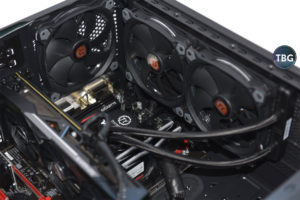 The Water 3.0 took us 35 minutes to install, not because it was more difficult than other models, however. In fact, ThermalTake’s Water 3.0 is based on a time-tested design, and the cooling block and radiator utilize a very standard Asetek design. A lot of people may not realize that the vast majority of liquid CPU coolers on the market are licensed under patent by Asetek, including both the Arctic and Thermaltake in our roundup, but extending to Corsair, Cryorig, EVGA, Fractal Design, NZXT, and even Intel. That means the radiator and cooling block used in this model looks and functions identically to others, right down to the cooling plate itself (being identical to the one on our Arctic cooler). Like the Arctic Liquid Freezer 240, it reuses the standard AMD backplate (although not the retention brackets), but unfortunately, unlike the Arctic model, the manual doesn’t actually specify that you need to reuse that bracket (and that your motherboard may in fact not have one if you got it second hand).
The Water 3.0 took us 35 minutes to install, not because it was more difficult than other models, however. In fact, ThermalTake’s Water 3.0 is based on a time-tested design, and the cooling block and radiator utilize a very standard Asetek design. A lot of people may not realize that the vast majority of liquid CPU coolers on the market are licensed under patent by Asetek, including both the Arctic and Thermaltake in our roundup, but extending to Corsair, Cryorig, EVGA, Fractal Design, NZXT, and even Intel. That means the radiator and cooling block used in this model looks and functions identically to others, right down to the cooling plate itself (being identical to the one on our Arctic cooler). Like the Arctic Liquid Freezer 240, it reuses the standard AMD backplate (although not the retention brackets), but unfortunately, unlike the Arctic model, the manual doesn’t actually specify that you need to reuse that bracket (and that your motherboard may in fact not have one if you got it second hand).
Speaking of the manual, Thermaltake actually included a few too many manuals, and it all came down to providing the extra AM4 compatibility in the box. First was the “Water 3.0 Riing RGB 280” manual, which failed ot include any mention of AM4. Then was a re-written “Water 3.0 Riing RGB” manual that had all the same information, plus details of the AM4 installation. Finally, there was an AM4 upgrade kit manual, which seemed completely unnecessary given that the AM4 instructions are actually included in one of the other two manuals. We’re betting this is simply a result of having to switch over an existing SKU to include AM4 compatibility. The updated manual may not have been ready in time, so Thermaltake is likely slipping it into boxes that already contain the old manual plus an AM4 upgrade manual. We hope Thermaltake will eventually ship this model with just one complete manual, because it literally took us at least 10 minutes trying to figure out which manual to follow. Also making things a bit more time-consuming was the separate RGB breakout box, which controls both the speed and lighting on the included Riing fans. On the other hand, there was one time-saving element of this installation: thermal paste comes pre-applied, unlike any other cooler in this roundup. This is great for convenience, but it does mean you don’t get a second shot at installation!
Summary Notes
As we mentioned on the previous page, one of the most critical factors in determining the ease of installation of a liquid cooler is the case you’re working with, and we really have to give Thermaltake credit for a job well done on its View 31. No, it doesn’t use the most cutting-edge design, but it’s a design done right, with a huge amount of headroom up top (where coolers ought to be installed, as opposed to the front panel). Alas, we know a lot of cases that advertise this type of compatibility really don’t have it. For example, we installed the Reeven Naia 240 in our SilverStone PM01 case for some testing you’ll learn about later in this article, and it actually touched our motherboard heatsinks, meaning we had exactly 0mm to spare! Neither the Arctic Liquid Freezer 240 nor the Thermaltake Water 3.0 280 would fit in the top of that case, despite it being marketed with this type of compatibility. The same holds true for the Phanteks Enthoo Pro M and other mid-sized Phanteks cases. So beware, and if you’re building your a system from scratch, always consult our DIY PC Buyer’s Guides for advice on cases and coolers that work well together!
Performance
At idle, liquid coolers can often be at a disadvantage, as their pumps must keep running, despite the low load. Let’s see how our contenders fare versus our monster air cooler from Noctua:
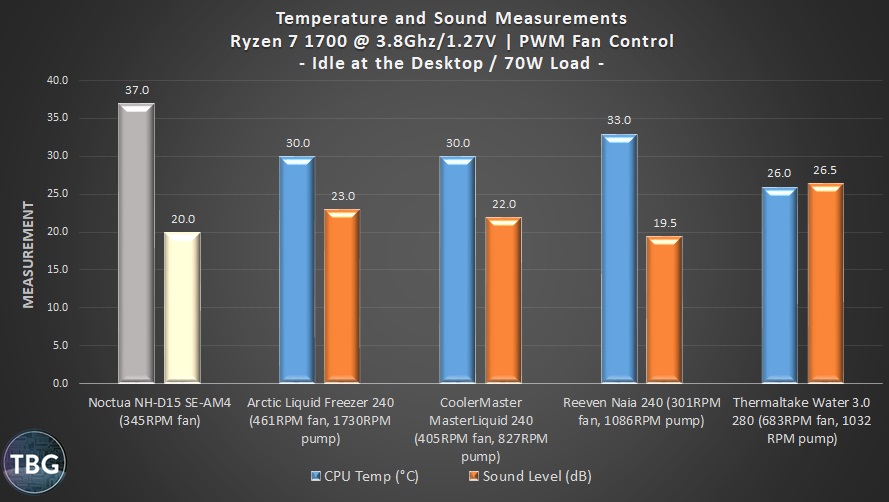
Very interesting. While the Noctua is indeed among the quietest coolers in the race, the Reeven Naia 240 came up with a shocking win, registering as nearly inaudible in our idle testing. But both of these coolers actually had a weakness not reflected in the numbers. The Noctua emitted some resonance, which we attribute to the dual-fan arrangement, causing airflows of different velocities to intersect each others’ path. We’ve never been sold on dual-fan air coolers, and this is one of the drawbacks. It’s not perceived as something loud, but rather a disruption in frequency, and human ears are very good at picking that kind of thing up. Similarly, the Reeven had a slight gurgling sound every few seconds, which may have resulted from running a low pump speed at idle.
Of note, the Thermaltake Water 3.0 wouldn’t work properly at all with the default fan curve (which set fans and pumps at 27% when below 40°C). It made a tremendous amount of noise, as the slow pump clearly wasn’t able to pull liquid through properly. We had to manually adjust the motherboard controls for the Thermaltake to ensure that pump RPMs stayed above 1000RPM; the 27% speed we used for other coolers set it at 900RPM. We make special note of this in case others come across the problem and think their Thermaltake coolers are broken – they are not! Alas, this did end up pushing the Thermaltake up to pretty high noise levels, so if quiet idles are your goal, this is not the cooler for you. We know a lot of older liquid coolers got around this problem with a fixed pump speed that was always running at maximum, but the drawback to this, as we’ll discuss more on the next page, is terrible idle noise. We’d much rather have to tinker with our idle fan curves to dial in a good setting for a liquid cooler’s pump than contend with an always-maxed arrangement.
While we really don’t care about temperatures at idle all that much, we would note that our air cooler was the hottest, and our most expensive liquid cooler, the 280mm Thermaltake, was the coolest, by far.
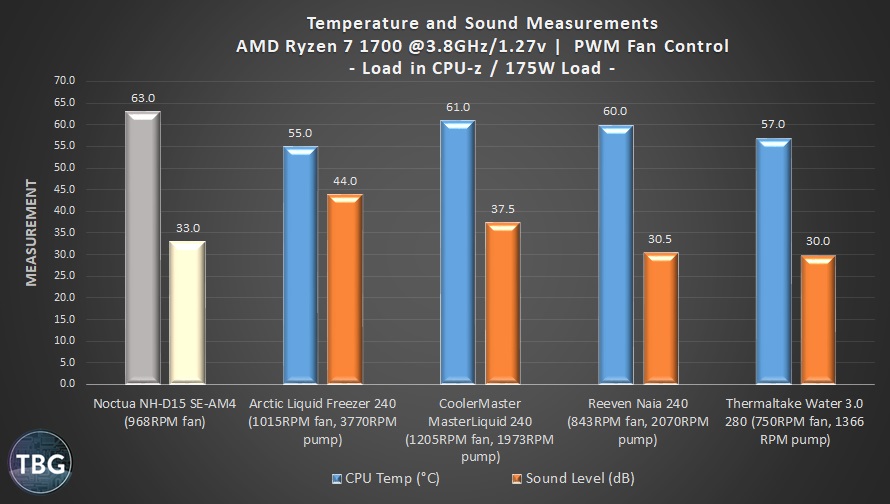
This is the test that most closely approximates the load presented by typical high-intensity applications, pushing our system to a 175W power draw at the wall. We’ve found these results to be nearly identical to what you’d see in a multi-player match of the game Battlefield 1, which is about as intense as a game can get. And if this is your typical “max load,” well then we have some clear winners and some clear losers, and they are often one and the same! The massive radiator and four-fan array on the Arctic Liquid Freezer 240 propels it to a big win, even beating out Thermaltake’s 280mm model, but ouch, look at those noise levels. Terrible, just terrible! On the flipside, the Reeven Naia was excellent and the Thermaltake was simply sublime, with the second best temperature and the lowest noise level. Our Noctua air cooler proved that massive amounts of metal can nearly take the place of liquid coolant, running a lot quieter than the CoolerMaster while providing nearly the same performance.
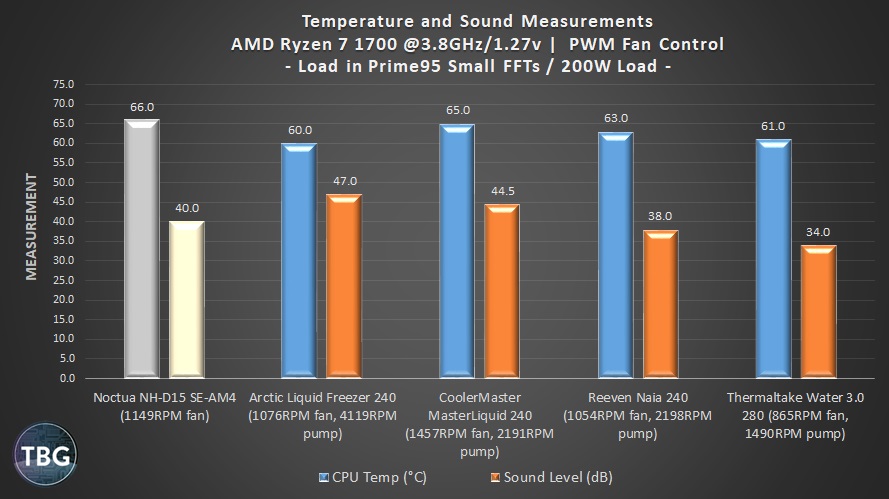
Now we really turn up the heat. Prime95 Small FFTs is an insane load, and our eight-core test system was drawing 200W during this test. Our reference Noctua air cooler again holds its own, nearly matching the MasterLiquid 240 while remaining much quieter. A very good showing for big air here, and not bad for the budget MasterLiquid, which needs to turn its fans at a higher RPM to compensate for what is probably a more basic radiator design. CoolerMaster lost a big lawsuit a few years ago to Asetek, and has since embarked upon designing its own coolers from scratch. If this is the result, we think it’s not bad at all, and the lower price can probably be traced directly back to the fact that Asetek isn’t getting a cut.
Alas, if you want the best performance, you need high-end liquid, and we were simply shocked at how well the Reeven Naia and Thermaltake Water 3.0 did despite noise levels that were below the Noctua’s! If you want to have your cake and eat it too, the combination of high performance and low noise levels these two coolers offer at their respective pricepoints is impressive.
And finally, we come again to the Arctic Freezer Liquid 240, which is clearly the “muscle car” of this roundup. It’s all about displacement, baby, and the Arctic comes away with a win here, but abandons all semblance of finesse in the process. Of particular note, the pump in our Arctic sample was registering at 4115RPM in this test, which seems absurdly fast, but it would certainly go a long way to explaining why the thing is so incredibly loud. The fans actually aren’t turning that fast, so we tend to trust the pump RPM reading we saw in HWMonitor. We find this particularly ironic given that Arctic is headquartered in Switzerland, the home of some of the most finely-tuned wrist-mounted machines in the world (i.e., watches). As we mentioned earlier, the Arctic is just a pumped-up Asetek clone, so in reality, it isn’t of Swiss provenance at all… it’s Danish!
Noise and Lighting Demonstration
To give you a better idea of what these coolers look like and sound like in actual use, we created a video compilation of all of them running through our Prime95 benchmark. We’ve ordered them from loudest to quietest according to our decibel meter, but you may find that certain pitches or tones are more noticeable even in coolers that are technically quieter, so pay attention!
Also on display were the various lighting effects, ranging from none (Arctic), to basic (CoolerMaster’s white LED logo), to flashy (Thermaltake’s Riing fans doing their cool RGB cycling), and to truly innovative (Reeven’s backlit colored liquid coolant!).
Comparison to the Corsair Hydro H100i v2 on the Intel X99 Platform
To give readers some context, we decided to mount one of our contenders in our Intel X99 platform to dual it out against our Corsair Hydro H100i v2, which we’ve been running in that test system since we first published our review of the cooler in early 2016. From among our new contenders, we chose the Reeven Naia 240, which comes it at nearly the same pricepoint (give or take a few dollars).
In this test, we ran our fire-breathing Intel Core i7-6900K at 4.2GHz, using 1.27V. Note that while we used to run this system at 4.4GHz using 1.35V, we degraded our CPU, and it can no longer sustain this overclock. Benchmarkers beware, if you’re using 1.35V or above, you might just be trashing your CPU!
That being said, even at 1.27V, this system just sucks down power, pulling 118W at idle and 220W in CPU-z (that’s 55W more than our Ryzen-based system). Because the Corsair is extremely loud in its “Performance” mode, we turned it down to “Quiet” mode to see if it would end up doing better. Here’s how it worked out at idle and CPU-z:
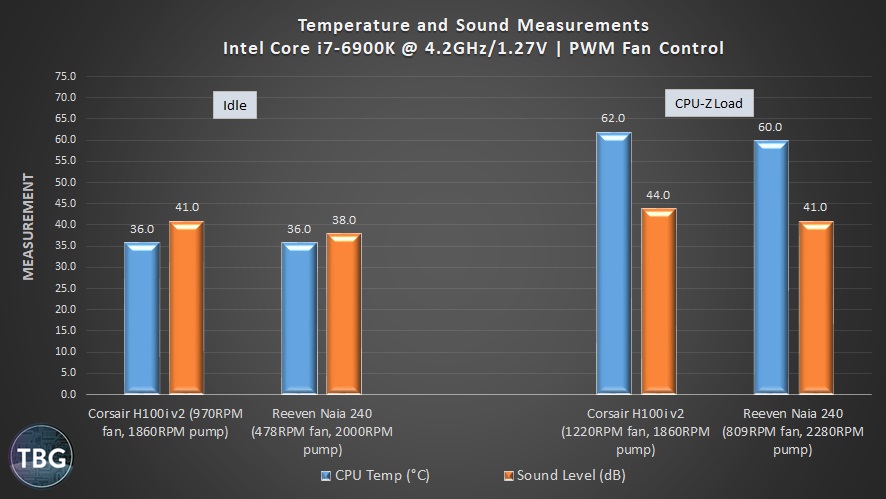
Clearly, the Corsair H100i v2 is outmatched by its newer competitor. One of the issues is that the H100i has is a fixed pump speed, which is far too loud at idle, and yet really too slow at load. It’s simply the worst of both worlds. And despite running its fans at much higher RPMs than the Naia 240, it’s the same temperature or hotter in both tests.
Folks, Corsair’s reign has come to an end. Yes, it will probably still hold nearly every spot in Amazon’s top 10 best seller list for a long time to come, but TBG readers now know better, and we’ll be updating all of our buyer’s guides next month to remove Corsair coolers from our recommended lists.
By the way, interesting fact for AMD fans – in the new ultra-intensive 3DMark Time Spy Extreme CPU benchmark, our Core i7-6900K outscored our Ryzen 7 1700 by just 12%, with 10.5% higher clockspeeds (4.2GHz vs. 3.8GHz at the same voltage). Thus AMD is only a few percentage points behind in terms of performance per clock cycle, which is amazing for a CPU that was released at $330 just one year after the 6900K debuted at over $1,000. Three cheers for competition!
The Final Tally
While we typically don’t assign multiple scores to products we review, we realized during our testing that there were so many criteria by which we could judge these coolers that we just had to break it down by more than just performance. So here we go, with each cooler being ranked from 1 (worst) to 5 (best) in five different categories:

The Performance Winner: This one’s easy. By virtue of its massive 38mm-thick radiator, quad-fan array, and ultra-high-speed pump, the Arctic Freezer Liquid 240 blew away the competition in terms of performance. Given that it’s also among the cheapest 240mm coolers available, it’s also the clear price/performance king. But it’s definitely not our favorite of this bunch…
The Value Winner: This one was a bit harder, as three coolers ended up around the same price: the air-based Noctua NH-D15 SE-AM4, the CoolerMaster MasterLiquid 240, and the aforementioned Arctic Freezer Liquid 240. But at press time, one was indeed a few dollars less expensive, and it was also a really well-balanced cooler, especially for people new to liquid cooling. Our “Value Winner” is none other than CoolerMaster’s MasterLiquid 240! It’s super-easy to install, reasonably quiet, and can sometimes be found for under $80, which makes it an exceptional deal. And yet, it’s not the cooler we’d choose for own system…
All-Around Winner and Conclusion
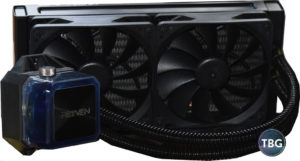 There was one cooler that stood out as the best overall package of the bunch, and that was the Naia 240 from Reeven. Being the very first liquid cooler ever released by the company, there was plenty of potential for failure, but clearly a lot of opportunity to think out of the box as well, and that’s what Reeven did. It truly impressed us with an amazing balance of performance and noise levels, along with straightforward installation and excellent compatibility that neither of the higher-performing coolers could match. Plus, with its unique transparent, refillable cooling block and dye packs, you can really come up with something that will stand out in a crowd. As shown here, we filled our sample filled with a mix of red and blue dye to come up with the purple color that went well with our RGB lighting scheme. With the four white LEDs shining through from behind the cover, it just looked stellar. Sure, RGB lighting is all the rage, but there’s something so “real” about seeing that liquid lit up and tinted your favorite color of the rainbow.
There was one cooler that stood out as the best overall package of the bunch, and that was the Naia 240 from Reeven. Being the very first liquid cooler ever released by the company, there was plenty of potential for failure, but clearly a lot of opportunity to think out of the box as well, and that’s what Reeven did. It truly impressed us with an amazing balance of performance and noise levels, along with straightforward installation and excellent compatibility that neither of the higher-performing coolers could match. Plus, with its unique transparent, refillable cooling block and dye packs, you can really come up with something that will stand out in a crowd. As shown here, we filled our sample filled with a mix of red and blue dye to come up with the purple color that went well with our RGB lighting scheme. With the four white LEDs shining through from behind the cover, it just looked stellar. Sure, RGB lighting is all the rage, but there’s something so “real” about seeing that liquid lit up and tinted your favorite color of the rainbow.
Now, an honorable mention goes to Thermaltake and its powerful Water 3.0 Riing RGB 280. If your case has room for a 280mm cooler (most do not), and your wallet can handle the $150 asking price, we’d actually go as far as to call this the “best” cooler in this roundup. It certainly had the best-sounding and best-looking fans, but it was let down by a dated Asetek-derived cooling block design that lacked any lighting whatsoever. Had we tested Thermaltake’s brand-new Floe Dual Riing RGB 280 instead, which features an RGB-lit cooling block for just a few dollars more, perhaps it would have been the winner.
And one last shoutout to Noctua for its impressive NH-D15. While it’s clearly pushing the boundaries of what can be done with air cooling, for anyone who just isn’t comfortable running a liquid-based cooler in their system, the Noctua serves up very decent thermals and low noise levels. Alas, for just $20 more, the Reeven Naia 240 is superior in every way, and that’s why the D15 isn’t going to get a full recommendation here.
We hope you’ve learned a thing or two about coolers in this article – we certainly did! Liquid coolers have really come a long way in the past few years, and we’re just glad so many manufacturers agreed to take part in this test. We think the variety of offerings painted a very complete picture of what’s available on the market today. In short, there are a lot of great options, as long as you go with a new model, and we’ll be recommending them in more of our DIY PC Buyer’s Guides going forward.
To see all our latest CPU Cooler recommendations at every price point and in every form factor, check out our CPU Cooler Buyer’s Guide, updated quarterly, or just go for the cooler that we picked for our own high-end system, the amazing new Reeven Naia 240, currently listed for $112 shipped from Amazon!

